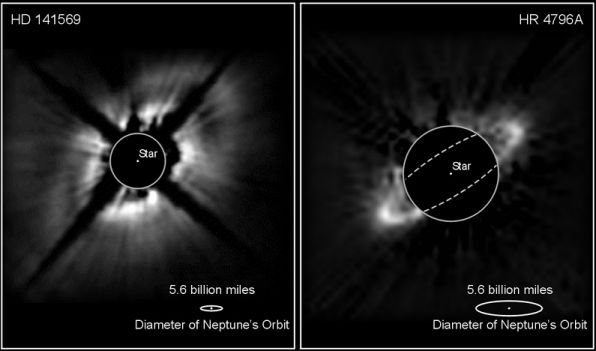Credit & Copyright: Left-
A. Weinberger, E. Becklin
(UCLA),
G. Schneider (U. Arizona),
NASA
Right- B. Smith (U. Hawaii), Glenn Schneider (U. Arizona), NASA
Explanation:
These near-infrared Hubble images of dust
surrounding young stars
offer the latest tantalizing evidence for planets
beyond our Solar System.
At left, the dark
gap seen in the dust disk is reminiscent of a similar
large gap in
Saturn's rings
believed to be sculpted by orbiting moons.
By analogy, the gap in
the dust disk of HD 141569 may be a larger scale
result of unseen orbiting planets.
At right is a relatively thin stellar dust ring
suggestive of planetary rings held in
place by orbiting moons.
On a much larger scale this ring around
the star HR 4796A could also
indicate the presence of orbiting planet-sized bodies too faint to be
directly visible.
For a distance comparison, the orbit of Neptune is drawn at the lower right
of each picture.
The overwhelmingly bright starlight at the center has
been blocked out to reveal the dim dust features.
Right- B. Smith (U. Hawaii), Glenn Schneider (U. Arizona), NASA
1999 2000 2001 2002 2003 2004 2005 2006 2007 2008 2009 2010 2011 2012 2013 2014 2015 2016 2017 2018 2019 2020 2021 2022 2023 2024 2025 |
Январь Февраль Март Апрель Май Июнь Июль Август Сентябрь Октябрь Ноябрь Декабрь |
NASA Web Site Statements, Warnings, and Disclaimers
NASA Official: Jay Norris. Specific rights apply.
A service of: LHEA at NASA / GSFC
& Michigan Tech. U.
|
Публикации с ключевыми словами:
extrasolar planet - dust - infrared - young stars - инфракрасное излучение - Планеты у других звезд - пылевой диск
Публикации со словами: extrasolar planet - dust - infrared - young stars - инфракрасное излучение - Планеты у других звезд - пылевой диск | |
См. также:
Все публикации на ту же тему >> | |
